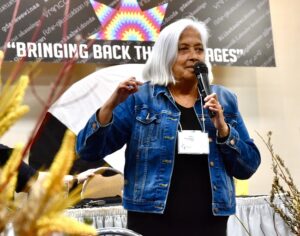Honouring the spirit of languages

By Kelly Anne Smith
NORTH BAY— The main venue smelled like summer with berries on all of the tables along with pine cones and rocks. Baskets of dogwood, spruce, and pussy willows were placed throughout the room, giving the comforting presence of nature while listening and learning at the Pus Kob Wiid Doon Amowin (Bringing Our Languages Back) conference hosted by the North Bay Indigenous Friendship Centre.
150 enthusiastic participants attended the March 27-28 conference at the Best Western in North Bay. Pus Kob Wiid Doon Amowin featured James Vulkelich of Turtle Mountain, Miriam Hall of Inuit heritage, Anishinabek Nation Head Getzit Richard Assinewai, Joan McLeod Shabogesic of Nipissing First Nation, Velma Assiniwe of Wiikwemkoong First Nation, North Bay Indigenous Friendship Centre President Maurice Switzer of Alderville First Nation, Wayne McKenzie of Timiskaming First Nation, and Micheline Hunter of Weenusk First Nation.
Traci Koritsaris is the Events Planner with the North Bay Indigenous Friendship Centre and says the conference aimed to bring back languages.
“It’s getting washed out these days being in an urban society, so we are trying to bring it back to families and help them remember where they came from and to honour their heritage and to be proud of it.”
Koritsaris explained workshops utilized language while participants got creative painting or deer-hide tanning.
“They teach you words as they are teaching the workshop. They are also teaching about the different struggles of having to learn the language and pass it on to your children so that they can grow up with it.”
Koritsaris is Inuit from Labrador. She says not a lot of people speak the language where they’re from.
“We are just trying to bring our heritage back. It’s special and we want them to learn, honour it and be proud of it.”
MC Bob Goulais from Nipissing First Nation introduced Joan McLeod Shabogesic, an honourary doctorate from Nipissing University, of the Crane Clan and the Red Tail Hawk Clan, a councillor and historian of Nipissing First Nation.
McLeod Shabogesic first presented on NBisiing Nishnaabewin ishi-wiinzh Names. As the Nipissing First Nation Land Manager for 37 years, she is knowledgeable. She pointed out three panels of historical information saying there are 50 that are erected on Nipissing First Nation’s Heritage Days. She then talked about the majestic Nipissing First Nation historical timeline that was laid out on many banquet tables. Started by a Nipissing University student, Joan has brought the beginning of the timeline to the ice age.
“It’s very important you look at the timeline and understand when the actual archaeology started in our area…This was found at Beaucage Park, these pottery pieces. They’re about 5,000 years old. They’re older than Stonehenge. If you look at this mammoth here for the ice age…There’s a 10,000-year-old site at Nipissing…Arrowheads depict the different pieces that we found. Our history is very, very long and extensive.”
McLeod Shabogesic says it’s important to know when the history began to be documented.
“Until this time, nobody classified. They just talked about it. This is how much time in history that has been lost. We have mounds in the states and probably in Canada here, different archaeology that have been built over. So, a lot of our history is lost that way.”
McLeod Shabogesic calls for new legislation concerning archaeologists.
“The worst thing I know about archaeology is that Ontario law allows an archaeologist to collect artifacts and have private collections. Those never get into museums or shared.”
Joan mentioned contributors to the NBisiing Names presentation as Norm Dokis, Peter Beaucage, Larry McLeod Shabogesic, Glenna Beaucage, June Commanda, Chris Mayne for providing maps, the British Museum, Nipissing Language Chart and Places, Nipissing University, and Dokis First Nation.
“Here’s what Nipissing means, according to June: Gchi Nibiinssing: Gchi is ‘big’, Nibi – water, underlined is little, and sing means ‘place’. That’s how June translates that language. June is one of our head translators at Nipissing. And she also holds the portfolio on Council for heritage, culture, and language.”
Joan has been working to find out what the clan structure was.
“About 1984, our Elders got together and they picked clans because they didn’t know what their clans were. My dad had picked beaver for Shabogesic. He joked about it saying he was a logging contractor, so he cut down trees. So, he says, ‘I’m like a beaver’…Commanda picked the eagle. Penasse is a bird. But what we are finding out is that they’re not the same as what history is showing us…In the Dokis Log Book, Shabogesic is described as a possible heron or crane.”
With the help of language holders and translators and her history research, Joan has been unearthing what names mean or how they came about. North Bay is giiwedino-wiikwed, the literal translation in Anishnaabemwin meaning where the waters flow into the lake. But Evelyn McLeod’s grandfather’s translation for North Bay was Ensawaakmik. The Manitou Islands are Mnidoo mnisan in Anishnaabemwin. And the French River is Wemitigoozhi-ziibi or Wemitgoswishag Ziibi.
Sturgeon River is Ziibi, Dokis Point is Abitawe, and Garden Village is Giitigaan.
Joan also talked of historical maps being full of information. A 1641 birch bark map of Lake Nipissing was projected. It was found attached to a tree at the ridge of the Ottawa and Lake Huron. It is in the British Museum.
“It’s the only one of its kind that we found that identifies how our people knew the land so well.”
Joan McLeod Shabogesic finished her presentation with, “I hope you learned something, miigwech.”


